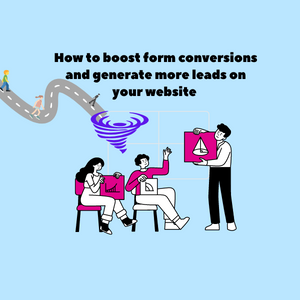Do you know that as many as 82% of small businesses are taking the help of digitalization to improve their daily operations, streamline processes, and increase revenue?
Technology has changed how we do everything – from shopping, banking, marketing, and everything in between. To keep up with the swiftly evolving trends, it is imperative that SME leaders up their technology game.
There is so much competition out there!
But don’t worry much – we have expert insights to help you in simplifying the process.
Recently, in an episode of the Canadian SME podcast titled, “Tech Consulting & SMB Digital Transformation”, co-founder of Customerization, a technology consulting firm specifically focused on SMBs, Anton Tchernikovsky discussed the importance of digitization for small businesses.
He talked about how digitalization is the need of the hour for small businesses and the role technology consulting firms play in helping them achieve this.
In this blog, we will summarize Anton’s views on the most important questions, like:
- What are the 3 most common technology-related challenges faced by businesses across industries?
- When should businesses start automating their business processes?
- What business processes to automate first?
- Technology transformation financing – what is the CDAP program by the Canadian Government, who should use it and how?
Let’s start!

What Are The 3 Most Common Challenges Faced By Businesses Across Industries?
As Customerization regularly helps businesses across different industries and countries to successfully incorporate the latest technology to digitize their operations, the first question to tackle is – what are the top 3 common challenges any SMB will most likely face..
And, here they are::
1. Choosing the right technology
With so many different software and platforms to choose from, it is understandable that businesses may become confused. Additionally, technology is constantly changing, making it difficult for businesses to keep up with the latest trends while also understanding their own needs.
2. Budget for digitalization
Another issue clients frequently face is understanding the amount of investment they will need to make or the total cost of acquiring the new platform. They have trouble figuring out how to calculate it, compare it with other benchmarks, and make sure it’s accurate and relevant for the specific needs of their organization.
3. Designing the implementation strategy
Another challenge is planning and allocating resources, especially when the business has never done this before. Technology implementation, even if and when outsourced, still requires resource allocation within the company.
It is often difficult to manage the additional effort required for implementation. It is also a challenge to familiarize employees with the new changes and make the transition smooth for them.
Therefore, thoroughly planning everything, from ideation to implementation is vital for small businesses so that this shift is worth the effort.
What Is The Ideal Stage at which SMEs Should Start Automating Business Processes?
This varies from company to company, based on the industry, type of company, and how long the business has been running. There are some young companies that are already digitized. Modern new companies are often digital-first, especially if they’re not coming from traditional, brick-and-mortar, verticals.They use technology from the very first day and therefore, don’t need to go through the digitization process.
However, for more older companies, it is not so easy because they have a set of routine processes and technologies that they’ve been using for quite some time. Breaking this pattern is hard.
Also, depending on the company, even the triggers are different. One trigger can be when a company meets bottlenecks in carrying out certain processes. Basically, they have the plans and potential needed to grow a business but their current operation cannot handle the volume of the business.
Another issue is the dependency on a certain employee for a particular task. As the company tries to scale up, workload increases, they need to hire new people to decrease this dependency.
Digitalization can help in resolving both these issues without breaking the bank. Therefore, if you need to scale up in a cost-effective manner, you’ll need to leverage efficient technology to streamline tasks.
What Processes Should Be Automated First?
Again, this depends on the nature of the business you’re doing. If your primary goal is to expand or increase your business, you should start with the automation of marketing and/or sales activities.
On the other hand, there are also companies that don’t face many problems with growing their businesses as they already have a good market share. But they might face issues in other, operational, aspects of the business. So they focus more on automating customer support, inventory management, automated billing, etc., to improve this.
Automation, therefore, leads to fewer issues, reduces operational costs, and frees up employees so that they can focus on more important tasks.
Best Starting Point for Non-Tech Savvy SMEs?
As Anton and his team work with a lot of non-tech-savvy clients, he recommends starting with getting a clear understanding of the business goals, without thinking about the technological aspects. Once this is done, you need to establish what is the success criteria for these goals.
Once you know what your goals are and how to determine whether they’ve been successfully accomplished or not, start planning it – as extensively as possible.
Work on the budget and roadmap. Keep the following in mind:
- Cost of software (subscription/ license rates for these software platforms)
- Whether you’ll need to hire an expert or not to implement the technology (mostly it’s a one-time investment)
- Internal resources (program managers, etc.)
Not to forget, the Canadian Government also has some programs that can help you finance these kinds of projects.
What is the CDAP Program and Who can Benefit from it?

CDAP – Canada Digital Adoption Program – is a great federal program offered by the Canadian Government as it enables small businesses to expand by providing them with the financial support required to plan and start the digital transformation of a company.
The program works on building up companies by providing them with the initial investment needed to plan the budget, develop a roadmap, compare different implementation styles, and choose the right platform to execute the final plan.
Basically, the program helps them build a strong foundation on which small businesses can successfully build their space in the market.
How can the CDAP Program help SMEs?
The CDAP focuses more on planning than implementation.
There is a reason why the program does this – to help small businesses get over the discomfort that is associated with the planning stage of such projects.
Even when you sit down to plan something strategically and work on developing a budget and roadmap, it needs a certain investment. However, a proper plan is a vital part of digitalization and that’s where CDAP steps in to help small businesses.
Therefore, the Canadian government provides up to 15,000 Canadian dollars to help them cover the cost of working with the certified Digital Advisor to deliver the personalized digital plan.
Which Businesses Qualify for the CDAP Program?
CDAP is a pretty new program. Usually, the process of applying and getting approval doesn’t take long. There are certain parameters based on which it is ascertained whether a business is eligible or not. After the approval comes through, it takes around a month to get the funding.
To be eligible for the grant, businesses must meet certain criteria:
- Be incorporated federally or provincially, or be a Canadian resident sole proprietor
- Be a for-profit, privately owned business
- Have between 1 – 499 full-time equivalent employees
- Have at least $500,000 of annual revenues in one of the previous three tax years
Once a business qualifies, they need to go through the Digital Maturity Assessment (online questionnaire) that helps the CDAP team to get a clear picture of the organization’s
- Structure
- Needs
- Strategic goals
- Business goals
- Technological stage
- The overall current stage of the company, and
- Technologies that are currently in use.
All these details are required since they then work on developing a strategic plan that includes how the company will operate moving forward, which areas will be digitized first, what can be done in phase two, and so on.
Typically, a minimum of three different ways of implementation are prepared. Then, the various technologies, vendors, and the approximate cost of the entire project are worked out.
All these deliverables are then presented to the company and management so that they can make a well-informed decision about which vendor they should work with. They can then work on getting quotes from the different vendors on the basis of the detailed analysis and then ultimately start the project with one of them.
As a certified Digital Advisor, Customerization has successfully helped many small businesses upgrade their services and enhance their day-to-day operations.
Therefore, if you’re a small business owner, make sure that you carefully go over all the valuable insights he has provided in this blog and don’t forget to check out Customerization – the one-stop-shop for all your digitalization needs.
And if you want to check out the podcast click here.




